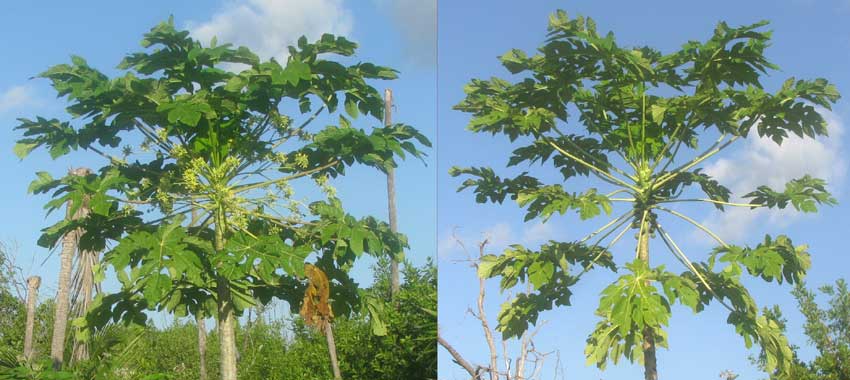Excerpts from Jim Conrad's
Naturalist Newsletter

from the April 17, 2011 Newsletter issued from Hacienda Chichen Resort beside Chichén Itzá Ruins, central Yucatán, MÉXICO; limestone bedrock, elevation ~39m (~128ft), ~N20.676°, ~W88.569°
MALE & FEMALE WILD PAPAYAS
Those big papayas we buy in markets grow on cultivated trees developed horticulturally from Wild Papaya trees, CARICA PAPAYA, which are native to the American tropics. In fact, Wild Papaya trees are among the most eye-catching species along our white sand road because they are so unlike other trees with their big, umbrella-like leaves arising atop thick, succulent, mostly unbranched trunks. Two Papaya trees are shown above.
Notice that flowers on the tree at the left grow at the end of long, branched stems. That tree is male. Flowers on the tree at the right arise directly from the trunk, and that tree is female.
It happens that three types of Papaya trees are recognized based on flower type: male, female, and hermaphroditic, or bisexual. Female plants produce blossoms bearing stigma, style and ovary, but lack pollen-producing stamens. If no male or hermaphroditic plants are nearby to provide pollen, female plants may fail to set fruit, though unpollinated female plants sometimes set parthenocarpic fruits lacking seeds.
Male plants usually produce no fruit.
Hermaphroditic plants may produce both male and bisexual flowers, depending on environmental conditions and the time of year. Hot, dry weather can cause the ovary not to form, resulting in male flowers.
You can see on the female tree at the right in the picture that the fruits -- the papayas -- are about the size of golf balls. On wild trees that's about as large as they get. When they turn orange they'll be edible and the flesh will taste OK, but there won't be enough flesh for most people to bother with. Birds, though, especially woodpeckers, love eating them.